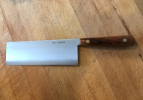I haven't read all the posts, but will offer some comments on hardness history and modern knives.
Picking the final hardness has always been a factor of available HT methods and the desired sharpenability.
Starting around 3000BC and continuing for several thousand years, knives were made of crudely smelted steel, and hardened by eye in some sort fire and in some sort of of home brew quenchant. The blades were sharpened on some sort of natural rock by hand. These blades were probably Rc 40 at the most. People considered that hard.
As time went by, steel was alloyed a bit better, rocks were hewn into grinding wheels and sharpening stones, and HT was a bit more refined. This was the norm from around 500AD to 1900AD. These blades were around Rc 45-50 at most.
People considered that hard.
It started improving during the last half of the 19th century with the advent of the Bessemer steel processes.
By 1900, steel metallurgy and manufacturing was pretty good and HT was much better understood. Alloying was still low and simple. Machinery was used to shape and grind the blades. HT was done to a max of Rc55. This would allow the user to easily sharpen the blade as it got dull. Home sharpening was still by a stone of some sort. During most of the 20th century, knives were between Rc45 and Rc55. People considered that hard.
Around 1990, with knifemaking becoming a popular hobby, and newer steels becoming available, hardness slid up to Rc 58-60 as the norm. Most everyone is very happy with this hardness range. This hardness could be easily shaped and sharpened on belt grinders with SC and AO belts and powered wet grinding wheels, and kept sharp by most users with a good Norton or other sharpening stone. To make sharpening easier, all sorts of sharpening systems and machines came out … with most ending up on shelves and in drawers. It wasn't that the Chef's Choice or Lansky couldn't sharpen a knife well … it was that they were expensive and required some skill. Good as they were, they left a poor edge more often than not and couldn't compare to a sharpening stone for ease.
With the advancements in both metallurgy and equipment of the last 20 years, Rc 63-65 blades are now possible and sharpening them can be done with our modern belts and equipment as well as diamond plates and laps. The issue is that the normal user can't maintain the edge easily. Diamond stones are available for the home user, but most people either don't use them or use them wrong. New sharpening equipment came out, some costing thousands of dollars, but it didn't change the public's desire to quickly and easily sharpen their knives.
The general public still wants a knife that is easily resharpened in the kitchen in a few minutes or less. Commercial knives, both kitchen and hunting/fishing, have barely increased in hardness since 1990. The vast majority still range between Rc55 and Rc58 . Kitchen knives have started to slide up to Rc60 only in the past few years. The trend for hobby knifemakers is to make them really hard and sharpen on their equipment. Rc 62-65 has started showing up often. You even hear about guys using special metal alloys and getting Rc67 knives. This is a good thing for the maker/user, but won't affect the public's oppinion much at all, due to the end user not being able to sharpen the knife properly himself.
The thing to keep in perspective is that
an Rc 55 knife will cut just as well as an Rc65 blade. The difference is in two main areas - Edge life, and edge durability. At Rc 65, the edge will not wear down and get dull as fast as the Rc55 edge, but it will chip much easier. The Rc55 edge can be quickly sharpened as often as needed, but the Rc65 edge will have to be sharpened using special equipment and skills. Again, the general public won't want a blade that will chip easily if misued or one that they can't sharpen easily.



